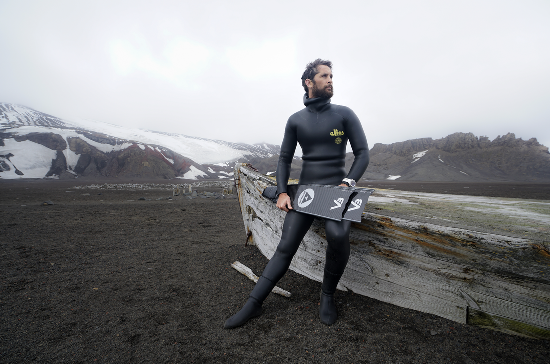DIVING IN ANTARTICA – WHAT TO WEAR FOR POLAR CONDITIONS
So having just returned from a month long expedition with my partner Sofia to Antarctica, I wanted to give a bit of feedback on how my freediving equipment held up in the TOUGHEST environment on earth!
I know I had a lot of questions floating around in my mind before the trip and although I knew that we would be using the best gear that money can buy, I’d be lying if I was to say that there wasn’t a few nerves about just how well we would be protected from the cold! And for those of you thinking about diving in the polar regions, under ice, with the orcas in Norway, between the continents in Iceland, freediving or spearfishing in the higher latitudes, this is a must read!
Let me start with the wetsuit because without it, I don’t think I would have lasted more than 5 minutes in the icy cold polar waters!
Wetsuit
Elios
- Tailor made 7mm Heiwa open cell neoprene, smooth skin black, jacket with incorporated hood and high waist pants

- 5mm socks smoothskin outer, superelastic nylon inner
- 5mm three finger gloves smoothskin outer, superelastic nylon inner
So the most vital piece of equipment! How did it hold up? Well, without a word of a lie, it worked great! And even better than expected. My previous experience with ‘cold water diving’ was in the murky realms of the freshwater lakes in New Zealand and Denmark, which are normally around 18-21C on the surface(in the summer) and depending on how far down you make it, they get to about 4-6C at depth. Not really what some of you would class as ‘cold water diving and on most occasions I wouldn’t be spending a great deal of time down in the coldest layer! My Elios 5mm Yamamoto suit would be good for about a couple of hours in relative comfort. Now, an extra 2mm of neoprene doesn’t sound like a lot and I have definitely had occasions when I’ve been cold coming out of the lake, so this is where the worrying thoughts started to come in, wondering if the 7mm would indeed be enough for sub zero degree temperature water!(Yep thats right, salt water in Antarctica can drop to as low as -2C!)
This anxiety wasn’t made any better when we stopped into the local dive shops in Punta Arenas in the south of Chile and we found them selling open cell suits that were up to 21mm thick! In the end I needn’t have worried though, the 7mm Heiwa neoprene had me perfectly insulated from head to toe! With only my face exposed, after the first two minutes(until my face went numb) I didn’t really feel a thing for at least the next 45 mins! After that the cold started to creep in, first to my fingers and toes and then to my core. If we remained completely immersed for the full duration we were capable of spending about 80 minutes in the water, if we were in and out we could last much longer. We did medical checkups before and after each dive session and the most we saw our core body temperatures drop was about 1.8C. We were cold at that stage for sure but still about 0.5C above becoming hypothermic and nothing that a pair of thermals, a warm drink and a woolly jumper couldn’t fix!
Now you might be wondering how well can you move with 7mm of neoprene encasing your body? Well the suit was surprisingly flexible and it wasn’t noticeably worse than my 5mm Yamamoto. This was my first Heiwa suit and in theory it should be less flexible than the Yamamoto neoprene but with the upsides of being warmer and more durable. We obviously weren’t doing any deep CNF dives or anything where we needed that extra flexibility so I’d have to say that the recommendation from Elios was good and I too would highly recommend this suit to anyone else considering diving in and around chunks of ice or spearfishing in Nordic type waters!
And the socks and gloves? Well normally I prefer to dive without socks. It just feels unnatural to me to not feel the water between my toes. Obviously wasn’t an option here and I was happy to have some neoprene between the sea and my feet! They were also comfortable to walk in, which we did during a visit to Deception island. Having the nylon inside meant that my feet didn’t slide around inside the socks like they would have with an open cell inner but this also meant that I wore them kinda thin on the seams outside and I had to touch them up with some neoprene glue once I got back onboard.
Having the three finger type gloves meant that I had some dexterity for using the camera whilst having more warmth by keeping most of my fingers grouped together. I have to admit they do look a little weird but hey, as freedivers I think we’re all used to having unusual practices and standing out in a crowd!(Apnea walking in public anyone?!) They kept my fingers warm enough but it was definitely my fingers and toes that were getting cold first. I don’t really see anyway around this to have the combination of dexterity AND warmth but if you need the dexterity for using a camera and you want to try thicker gloves makes sure that you’re really familiar with your setup because for me 5mm of rubber was about the limit.
Oh yea and one additional piece of advice, don’t forget to tuck your socks under your wetsuit legs before going into the water, a sock full of icey water and you will definitely know all about it!
Fins
- Alchemy
- V3 Carbon Fibre customs blades
I have been using Alchemy fins now since 2014 and I’ve never yet been disappointed. We opted to go with slightly stiffer blades(medium) than we normally use(medium soft) to give a little more power per stroke to compensate for the thick wetsuits(extra buoyancy) and the 8 kg of lead that I was using. This worked well and I think we got the balance about right with our setup. I didn’t feel any leg fatigue, even on the toughest dives.
Now something slightly out of the norm that Alchemy did for us(by request) was they sent the fin blades and the foot pockets unassembled, along with an assembly kit. As we were unsure of what size foot pockets(FP) we would need with the thicker socks we opted to take both one size and two sizes above what we normally wear so that we could test them out before assembling them. It turns out that we both needed two sizes above and so with the help of a beautifully made instruction video we set about the messy task of gluing them together. The end result was good, although I have a new appreciation for the level of expertise the guys at Alchemy have in the makings of their fins, I’d say I spent at least twice(ok four times) as long as they do in cleaning them up!
Dive Computer
- Suunto
- d6i, d4i
So how did the dive computers hold up in the cold? Well the watches themselves were great, never once missing a beat, no leakage, fogging up or any other sort of unwelcome surprise! You might expect this from a sturdy, well built piece of equipment such as the Suunto d6i and d4i and lets face it, they aren’t the cheapest options on the market. But it is good to know that if you are spending that little bit extra that what you are buying will standup to diving in the TOUGHEST elements on EARTH!
One issue we did have, which was not an issue with the watch itself but something which perhaps we should have anticipated should we have put a little bit more thought into it, was the reduced battery life(from the cold). After AT LEAST a full season of diving I have surely depleted a good amount of my battery, and each time I got into the water the gauge would warn me that I was low on battery. However my gauge continued to work throughout the entire expedition but unfortunately for Sofia her battery became too low to work in dive mode. Now that we are back in the warmth of Colombia funnily enough Sofia’s gauge says ‘battery ok’, so definitely a cold related issue!
So the lesson in this, unless you have a near new gauge the safest option to have a working dive computer for the duration of your expedition is to make sure you get your dive computer serviced before you head out to the polar regions!
Weights and weight belt
- Alchemy
- 5mm Silicone
Any decent weight belt will do, we used belts by Alchemy and I opted for the 5mm option as it is both stronger and comes with the metallic buckle which would have less chance of opening than a plastic type. Being that you’re going to need a lot more lead than in warmer waters(I had 8KG, in a 3mm I’ll use 2KG, in a 1.5 I’ll use 1KG or less) make sure that you haven’t cut your belt too short and also remember to bring a piece of cord (that you can tie to the front and back of your belt passing between your legs) so that when you turn upside down you don’t end up with the weights riding up to your armpits! This isn’t something that I normally need to do but trust me, with the extra lead, you will need to do it!
In summary I’m more than happy with our equipment and I wouldn’t make any changes if I was to repeat the experience. And although there were some days that were absolutely glorious out on the frozen continent, there were definitely a few where mother nature let you know that you were in fact diving at the end of the earth!
Don’t forget to leave a comment below and if you think this article has been useful or interesting please give it a share! Also check out our adventures in picture form by following @johnnydeep110 and @sofigomezu on instagram!
AND for the VERY BEST in freediving training why not join us for a Training camp in the Caribbeans Nature island, Dominica!
(http://www.jonathansunnex.com/blog/what-to-wear-in-antarctic-conditions)
